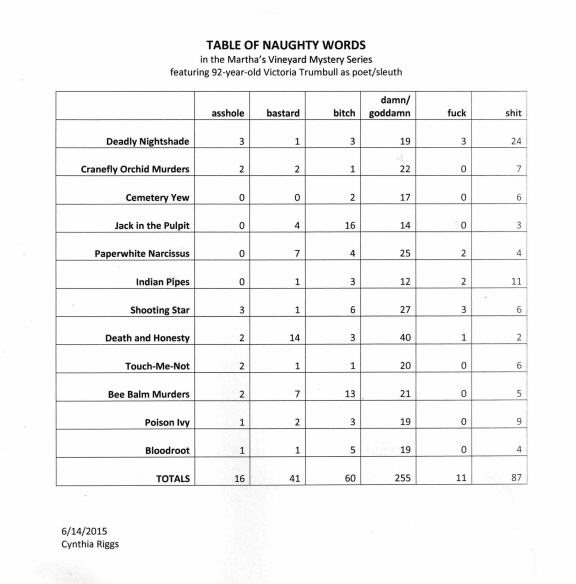Some letters are friendlier to the Blogging from A to Z Challenge than others. Which is to say I could get through the month on maybe eight letters and never run short of topics. Other letters, however . . . On my brainstorm list I’ve got no shortage of Cs, Fs, and Ss but blanks for K, L, N, O, U, V, X, Y, and Z. Not to worry: one thing you learn and keep relearning as a writer to trust the process and don’t panic. The muses will come through if you let them.
I came to blogging rather late in the game, like early in 2011. My first blog was From the Seasonally Occupied Territories, about being a longtime year-round resident of Martha’s Vineyard. Most widely circulated writing about the Vineyard is done by people who haven’t spent enough time here to know what they don’t know, so I wanted to do my bit to correct the imbalance.
Maybe three years later I started this blog, Write Through It. Since 1997 I’d been an active contributor to online editors’ groups, first Copyediting-L and eventually the Editors’ Association of Earth groups on Facebook. It dawned on me that not only was I learning a lot from these ongoing discussions — they’re great continuing education for freelancers — I’d been editing and writing long enough to have a lot to offer my colleagues. Why not put some of it in a blog?
The cataclysmic U.S. election year of 2016 redirected my energies in a big way. My blogging output is way down, I’m not actively following nearly as many blogs as I used to, and most of the people who’ve subscribed to mine in the last few years have no apparent connection with the subjects. But it’s still a pretty good way to get your words out there and maybe start developing an audience.
As a matter of fact, a little over a month ago I started a new blog: The T-Shirt Chronicles. My more than 190 T-shirts span my life back to 1976, so I’m using them to organize a sort of memoir. Perhaps it’ll eventually turn out to be the rough draft for a book, but for now it’s a work in its own right.
During the first half of the 1980s I was the book buyer at Lammas, D.C.’s feminist bookstore. Bookstores testify to the the power of the written word. I had a personal relationship with every book on the shelves. It was there because I’d ordered it, and like as not I’d unpacked it, logged it into inventory, and shelved it. Whether I’d read it or not, I knew enough about it to point customers toward it if they might be interested in the subject or the author.
And almost every day I got to listen to customers talk about how a particular book or story had affected them, or even changed their life
Though I left both the job and D.C. in 1985, and though the store — like so many feminist and other independent bookstores — no longer exists, it’s my experience there that gets me through the times when my faith falters and I’m sure that writing doesn’t matter. If you’re lucky enough to live within reach of a real live bookstore, you probably already know the feeling. Clicking through the options at Mega Online Retailer doesn’t come close.




 Lynn Christoffers is a wonderful photographer. Cats are her favorite subject, so Cats of Martha’s Vineyard was a natural. But she did more than photograph a hundred cats. She interviewed their people and turned those interviews into a book. I’m a chronic dog person, but I still think it’s cool.
Lynn Christoffers is a wonderful photographer. Cats are her favorite subject, so Cats of Martha’s Vineyard was a natural. But she did more than photograph a hundred cats. She interviewed their people and turned those interviews into a book. I’m a chronic dog person, but I still think it’s cool. Shirley Mayhew moved to Martha’s Vineyard as a young bride in 1947 and has been here ever since. Her personal essays, collected in
Shirley Mayhew moved to Martha’s Vineyard as a young bride in 1947 and has been here ever since. Her personal essays, collected in 